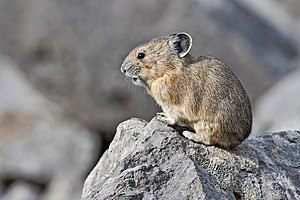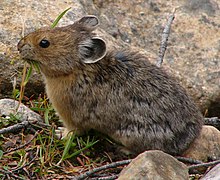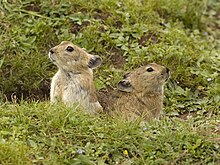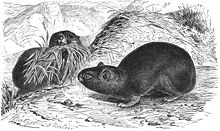Whistle hares
| Whistle hares | ||||||||||||
|---|---|---|---|---|---|---|---|---|---|---|---|---|

American pika ( Ochotona princeps ) |
||||||||||||
| Systematics | ||||||||||||
|
||||||||||||
| Scientific name | ||||||||||||
| Okhotona | ||||||||||||
| Link , 1795 |
Pfeifhasen ( Ochotona ), sometimes also called Pikas , is the only genus of the family of the Pfeifhasen ( Ochotonidae ) from the order of the hare-like (Lagomorpha) still represented today . It consists of around 30 living species. The animals got their name because of the high tones they emit as warning and recognition signals. Pikas are distributed over large parts of the northern hemisphere, especially in colder areas and in mountainous regions. Most of the diurnal animals live partly in colonies and feed exclusively on plants.
features
general characteristics
Although the whistling hares are the closest relatives of the hares , they differ from these outwardly very clearly. They are comparatively small and, depending on the species, reach a body length of 13 to 30 centimeters, on average around 20 centimeters. The body is compact and egg-shaped, the species are very similar and homogeneously built. The head is rounded, the ears are usually small and round to oval, especially in comparison to the rabbits. The legs are relatively short, with the rear limbs slightly longer than the front. The front feet each have five toes, the rear feet each have four toes. The dense and soft fur is mostly gray-brown, sand-yellow or reddish-brown in color, with the upper side often being somewhat darker than the underside; however, it can also be significantly lighter or white. Melanism occurs in some species, and in these there are correspondingly completely black individuals. The tail is very short and invisible because it is hidden under a flap of skin.
Features of the skull
| 2 | · | 0 | · | 3 | · | 2 | = 26 |
| 1 | · | 0 | · | 2 | · | 3 |
The skull of the pika is elongated and significantly smaller compared to most rabbits. The sides of the frontal bones do not have a supraorbital process, and there is a large cranial window on the sides of the nasal bones . Within the species, the formation of the openings in the palate is an important distinguishing feature: In some species, the incisor windows are fused with the palate window and accordingly form a single, usually pear-shaped window.
The animals of the genus have in the upper jaw each two cutting teeth (incisors) followed by a longer tooth gap ( diastema ) and three Vorbackenzähnen (Praemolares) and two molars (molar). In the branch of the lower jaw there is only one incisor and only two premolars, but three molars. The animals have a total of 26 teeth.
distribution
Pigeon hares are common in Asia and two species in western North America . In Asia, its distribution area extends from the Volga via Central Asia to Siberia and Hokkaidō , including Mongolia , western China , and the Himalayan region. The two American species live in North America from eastern Alaska to the northwestern United States .
Paleontologically, pigeon hares have also been identified in Europe. The steppe whistle hare ( Ochotona pusilla ) occurred in historical times as far as the Ukraine ; fossil finds have proven the species as far as the Iberian Peninsula and Great Britain .
Way of life
Whistling hares are mainly found in temperate and cooler climates . Their habitat includes steppes and open grasslands as well as mountainous regions up to 6000 meters above sea level, where they are mainly found in scree slopes and rugged terrain. They are predominantly crepuscular , but can also be seen during the day. Although many species live in cold areas, they do not hibernate. While the steppe-dwelling species often live together in large groups and dig earthworks, the mountain-dwelling species tend to be solitary. They mark their territory with feces or glandular secretions and defend it vehemently against other conspecifics.
nutrition

The diet of the pigeon hares consists mainly of grasses, herbs and plant stems. For the nutrient-poor winters, they build up food supplies from hay . To do this, they bite off grasses just above the roots, sometimes let them dry in the sun and then bring them into their burrows. A bed of a single animal can contain up to six kilograms of hay.
Reproduction
Much like the hares, pipebunnies are characterized by a high fertility rate. Two or three times or more often a year the female gives birth to up to twelve young animals. Newborns are naked and helpless, but they grow very quickly. They are weaned after three to four weeks and often reach sexual maturity in their first year of life.
Systematics

The taxonomic classification and the internal systematics of the Pfeifhasen is difficult and changed several times over time, which can be attributed to the great similarities of the individual species. Especially in the last few years there have been some major shifts within the phylogenetic system of animals on the basis of molecular biological and craniometric characteristics. In some cases, species already considered to be established were synonymous with others or declared subspecies of other species, but in some cases new subspecies and species were also described.
Today the genus is subdivided into a total of about 30 living species, whereby the specific species status of individual species and also the allocation and distribution of subspecies is very much dependent on the source considered. The following system is based on the representations of Andrei Alexandrowitsch Lissowski in his revision from 2014 and in the Handbook of the Mammals of the World from 2016:
- Subgenus Ochotona
- Gansu Pika ( Ochotona cansus )
- Tsing Ling Pika ( Ochotona syrinx )
- The black-lipped pika ( Ochotona curzoniae ) lives in the highlands of Tibet .
- The Daurian Pfeifhase ( Ochotona dahurica ) is also a steppe inhabitant. He lives in southeastern Russia, Mongolia and northern China.
- Nubra pika ( Ochotona nubrica )
- The steppe whistle hare ( Ochotona pusilla ) inhabits steppes in Russia and Central Asia. The species used to be widespread in Ukraine and western Russia, but has become extinct there. The species is considered endangered due to the scarcity of habitat.
- The Afghanistan pika or reddish pika ( Ochotona rufescens ) is native to the mountains of Turkmenistan , Iran and Afghanistan .
- Ochotona sikimaria
- Moupin Pika ( Ochotona thibetana )
- Thomas Pika ( Ochotona thomasi )
- Subgenus Pika
- The Altai pika ( Ochotona alpina ) lives in mountainous regions in Kazakhstan , China and Siberia .
- Silver pika ( Ochotona argentata )
- The Alaska pika ( Ochotona collaris ) lives in eastern Alaska and northwestern Canada ( Yukon , British Columbia ).
- The Korean Pika ( Ochotona coreana )
- The Hoffmann Pfeifhase ( Ochotona hoffmanni )
- The Northern Pika ( Ochotona hyperborea ) lives in Siberia, Korea and on the Japanese island of Hokkaidō
- The Manchurian Pika ( Ochotona mantchurica )
- The Kazakh pika ( Ochotona opaca )
- Mongolian Pika ( Ochotona pallasi )
- The American pika ( Ochotona princeps ) lives in mountainous regions in southwestern Canada and in the western United States .
- The Turuchan Pika ( Ochotona turuchanensis )
- Subgenus Conotha
- The red-eared pika ( Ochotona erythrotis )
- The Forrest Pika ( Ochotona forresti )
- The Glover Pika ( Ochotona gloveri )
- Ili pika ( Ochotona iliensis )
- The koslow pika ( Ochotona koslowi )
- The Ladakh Pika ( Ochotona ladacensis )
- The big-eared pika ( Ochotona macrotis )
- The Royle Pika ( Ochotona roylei )
- The red pika ( Ochotona rutila )
Wilson & Reeder 2005 distinguish between these species and Ochotona huangensis ( a subspecies of the Daurian pigeon hare according to Lissowski 2016), the mule pigeon hare ( Ochotona muliensis ; considered by Lissowski as a synonym of the Glover whistle hare) and the Himalayan whistle hare ( Ochotona himalayana ; from Lissowski regarded as a synonym of the Royle pika). In addition, there were the Gaoligong pika ( Ochotona gaoligongensis ) and the black piper ( Ochotona nigritia ), which are currently considered synonyms and color variants of the Forrest piper . Ochotona sikimaria , traditionally a subspecies of Ochotona thibetana , was granted species status in 2016.
The Sardinian Pfeifhase ( Prolagus sardus ) still lived in historical times on Corsica , Sardinia and neighboring islands. Hunting and competition from introduced animals are likely the reasons for the extinction of this species. The last sighting dates from the 18th century. The Corsican pika (formerly Prolagus corsicanus ) lived in Corsica and is a subspecies according to today's view.
Hazard and protection
Whistling hares tend to inhabit remote regions that have not been touched by humans. In Central Asia and China, they are sometimes viewed as a nuisance as they devastate fields and nibble on trees. Sometimes people also take their supplies of hay to feed their livestock, which causes many animals to starve. In some regions (for example in Ukraine and in western Russia ) they have become extinct, other species have become rare due to urban sprawl. The IUCN lists two species as threatened and several others as endangered.
supporting documents
- ↑ a b c Family Ochotonidae, Genu Ochotona. In: Andrew T. Smith , Yan Xie: A Guide to the Mammals of China. Princeton University Press, 2008; P. 275. ISBN 978-0-691-09984-2 .
- ↑ César Laplana, Paloma Sevilla, Juan Luis Arsuaga, Mari Carmen Arriaza, Enrique Baquedano, Alfredo Pérez-González, Nieves López-Martínez: How Far into Europe Did Pikas (Lagomorpha: Ochotonidae) Go during the Pleistocene? New Evidence from Central Iberia. PLOS One, November 4, 2015. doi : 10.1371 / journal.pone.0140513 .
- ↑ CT Fisher, DW Yalden: The steppe pika Ochotona pusilla in Britain, and a new northerly record. Mammal Review, November 23, 2004. doi : 10.1111 / j.1365-2907.2004.00052.x .
- ↑ a b Don E. Wilson & DeeAnn M. Reeder (Eds.): Ochotonidae in Mammal Species of the World. A Taxonomic and Geographic Reference (3rd ed).
- ↑ a b c d AA Lissovsky: Ochotona. In: Don E. Wilson, TE Lacher, Jr., Russell A. Mittermeier (eds.): Handbook of the Mammals of the World: Lagomorphs and Rodents 1. (HMW, Volume 6), Lynx Edicions, Barcelona 2016; P. 47 ff. ISBN 978-84-941892-3-4
- ^ Andrey A. Lissovsky: Taxonomic revision of pikas Ochotona (Lagomorpha, Mammalia) at the species level. In: Mammalia 2014; 78 (2): 199-216. doi : 10.1515 / mammalia-2012-0134
- ^ A b N. Dahal, AA Lissovsky, Z. Lin, K. Solari, EA Hadly, X. Zhan, U. Ramakrishnan: Genetics, morphology and ecology reveal a cryptic pika lineage in the Sikkim Himalaya . Molecular Phylogenetics and Evolution 106, 2016; Pp. 55-60. doi: 10.1016 / j.ympev.2016.09.015
literature
- Joseph A. Chapman, John EC Flux (Eds.): Rabbits, Hares and Pikas. Status Survey and Conservation Action Plan. (PDF file; 10.7 MB) International Union for Conservation of Nature and Natural Resources (IUCN), Gland 1990; Pp. 43-46. ISBN 2-8317-0019-1 .
- AA Lissovsky: Okhotona. In: Don E. Wilson, TE Lacher, Jr., Russell A. Mittermeier (eds.): Handbook of the Mammals of the World: Lagomorphs and Rodents 1. (HMW, Volume 6), Lynx Edicions, Barcelona 2016; P. 28 ff. ISBN 978-84-941892-3-4
Web links
- Video and information on GEO.de
